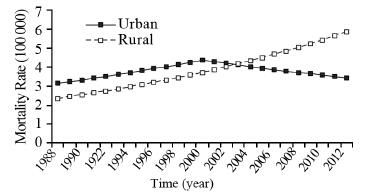文章信息
- 许林平, 刘阳,张萌,阴蒙蒙,刘曙正. 2015.
- XU Linping, LIU Yang,ZHANG Meng, YIN Mengmeng, LIU Shuzheng. 2015.
- 河南省居民1988—2012年女性乳腺癌死亡率趋势分析及预测
- Time Trend and Prediction of Mortality of Female Breast Cancer Patients in He'nan Province, 1988-2012
- 肿瘤防治研究, 2015, 42(01): 65-68
- Cancer Research on Prevention and Treatment, 2015, 42 (01): 65-68
- http://dx.doi.org/10.3971/j.issn.1000-8578.2015.01.016
-
文章历史
- 收稿日期:2014-08-02
- 修回日期:2014-10-27
乳腺癌是女性常见的癌症之一。2012年全世 界范围内每年女性乳腺癌的估计发病人数约为167 万,死亡人数约为52万,死亡率占女性恶性肿瘤死 因的第1位[1]。同时,乳腺癌发病率的时间变化呈 明显上升趋势,近30年期间全球乳腺癌发病率上升近1倍[2]。中国每年女性乳腺癌的发病人数约为 28.3万,死亡人数约为6.8万,死亡率位居女性恶性 肿瘤死亡的第6位[3]。10年前数据显示河南省的女 性乳腺癌死亡率呈上升趋势[4],为进一步观察河南 省女性乳腺癌死亡率时间变化特征及未来疾病负 担水平,本研究对河南省1988—2012年这25年间 乳腺癌死亡数据进行趋势分析,估计河南省女性 乳腺癌死亡的时期变化趋势,预测未来河南省女 性乳腺癌死亡水平。为河南省乳腺癌的病因学研 究和防治效果评价提供线索,为评估乳腺癌疾病 负担、制定乳腺癌预防控制措施提供参考依据。 1 资料与方法 1.1 资料来源
河南省乳腺癌死亡资料来源于河南省癌症 及生命统计中心,覆盖河南省1/10以上人口。资 料收集以河南省癌症及生命统计中心为领导,由 市级疾病预防控制中心与市级医院、镇区卫生院 与社区卫生服务站组成的三级防癌网共同完成。 由专业登记人员审核填写《死亡医学证明书》, 并将从公安、民政、卫生、计划生育等部门查取 的资料相互比对,确保数据的准确、完整和可 信。人口资料来源于相应登记点的统计与公安部 门。从河南省数据库中抽取国际疾病分类第10次 修订(international classification of diseases,10th revision,ICD-10)中编码为C50乳腺恶性肿瘤死 亡记录和相应的人口数据。采用1982中国标准人 口构成计算中国人口标化死亡率(以下简称中标 率),采用世界标准人口构成计算世界人口标化 死亡率(简称世标率)。 1.2 Joinpoint模型分析
Joinpoint模型是描述某种癌症死亡率和发病 率的连续变化趋势。以乳腺癌的标化死亡率为 因变量,年份为自变量建立对数线性方程,利 用Joinpoint4.0进行分析。分析年度变化百分比(annual percent change,APC)和估计年度变化百 分比(estimated annual percent change,EAPC) , P<0.05表示差异有统计学意义。 1.3 死亡率预测分析
利用贝叶斯年龄-时期-队列模型(Bayesian Age-Period-Cohort Modeling)对死亡数据进行拟 合,预测2012—2020年河南省不同地区恶性肿瘤 的死亡率。本研究应用BAMP[5, 6]软件进行数据分 析,丢弃最初运行时的10 000次Gibbs抽样,以消 除人为设定的初始值的影响,运行中采用马尔可 夫链蒙特卡洛方法(Markov chain Monte Carlo) 迭代1百万次使X(t)分布收敛到一个平稳状态, 并最终得到参数估计结果。 2 结果 2.1 死亡水平描述
河南省1988-2012年合计女性乳腺癌死亡率 为5.06/10万,中标率为4.03/10万,居女性癌症死 因的第5位,占女性癌症死亡总数的5.51%。城 市地区女性乳腺癌死亡率为4.75/10万,中标率为 3.76/10万,居城市女性癌症死因的第6位,占女 性癌症死亡总数的7.41%。农村地区女性乳腺癌 死亡率为5.08/10万,中标率为4.07/10万,居农村 女性癌症死因的第5位,占女性癌症死亡总数的 5.42%。城市农村地区各时期的女性乳腺癌死亡 率自1988—1992年到2008—2012年呈逐渐上升趋 势,见表 1。2008—2012年城市、农村乳腺癌年 龄别死亡率显示,在30岁年龄组以前死亡率处于 较低水平,此后死亡率随着年龄的增长而快速上 升,在80岁以上年龄组达到最高水平,城市、农 村地区在80岁以上年龄组的死亡率分别为27.03/10 万和34.00/10 万,见图 1 。
 |

|
| 图 1 河南省女性乳腺癌年龄别死亡率 Figure 1 Age-specified mortality rate of female breast cancer patients in He’nan Province |
城市地区的乳腺癌死亡率变化趋势中, 1988—2000年与2000—2012年两个时间段APC变化之间的差异有统计学意义,1 9 8 8—2 0 0 0 年和2000—2012年两个时间段的EAPC分别为 2.8%和-2.0%,95%置信区间分别为0.9%~4.7% 和-3.8%~-0.2%,两个时间段死亡率趋势差异均有 统计学意义。农村地区女性乳腺癌死亡率时间变 化趋势中,1988—2012年EAPC为3.9%,95% 置信 区间为3.2%~4.5%,其上升趋势有统计学意义, 见图 2。

|
| 图 2 1998—2012年河南省女性乳腺癌中标率时间变化趋势 Figure 2 The time trend of age-adjusted mortality rate of female breast cancer patients in He’nan Province from 1988 to 2012 |
采用年龄-时期-队列的贝叶斯模型对未来8年 (2013—2020年)城市、农村地区乳腺癌死亡率 进行预测,预测结果显示,城市女性乳腺癌的预 测标化率呈下降趋势,而农村地区无明显上升或 下降趋势,见图 3。2013—2020年,城市地区乳 腺癌粗死亡率变化不大,而农村地区粗死亡率从 7.84/10万上升到9.14/10万,见表 2。

|
| 图 3 河南省女性乳腺癌预测中标率 Figure 3 Predicted mortality rate of female breast cancer patients in He’nan Province |
 |
最新统计显示,河南省乳腺癌死亡率已跃居 女性癌症死亡原因的第5位。河南省女性乳腺癌 标化死亡率从1988—1992年的2.68/10万上升至 2008—2012年的5.04/10万。30岁以上年龄组死亡 率随年龄增加而快速增加。城市乳腺癌死亡率近 年有所下降,而农村地区一直呈明显上升趋势。
乳腺癌的全球分布差异巨大,普遍认为可以 用遗传、生活方式和环境暴露因素的不同解释[7]。 乳腺癌流行病学研究和防治工作的开展,需要长 期稳定的发病、死亡和生存监测资料的积累,需 要进一步加强我国肿瘤监测体系建设,提高登记 质量,以获取完整、有效的乳腺癌发病、死亡和 生存信息,为我国乳腺癌综合防治与研究提供基 础数据[8]。
乳腺癌死亡率的变化受到发病率和生存率的 双重影响。最近欧美国家乳腺癌死亡率出现下降 趋势主要归因于乳腺癌的人群筛查和治疗水平的 提高[9]。虽然我国大城市的乳腺癌发病率近10余年 上升明显,但在中小城市和农村地区女性乳腺癌 的发病与死亡率增长的速度更快[10, 11, 12, 13]。2010年河 南省城市乳腺癌的发病率仍高于农村[2],但由于城 市地区拥有更好的经济水平和医疗资源,2003年 后城市地区乳腺癌的死亡率已低于农村地区,显 示了由于生存率的不同,城市与农村地区出现了 不同的乳腺癌死亡趋势。但由于人口老龄化的影 响,虽然河南省乳腺癌中标率有所下降,但乳腺 癌的粗死亡率仍然较高。同时,由于治疗手段的 发展,治愈效果的提高,乳腺癌患者生存期也在 逐渐延长[14, 15, 16, 17],乳腺癌现患病人的数量会进一步增 加,相应加重了医疗卫生服务需求负担。
因此,河南省乳腺癌防控策略的重点应放在 农村地区,针对性的控制乳腺癌危险因素,在高 危人群中积极开展乳腺癌筛查工作,优化农村乳 腺癌防控医疗资源,规范诊治路径,全面提高乳 腺癌预防与控制的整体水平,最大限度地减轻社 会的乳腺癌疾病负担。
| [1] | Ferlay J, Shin HR, Bray F, et al. Estimates of worldwide burden of cancer in 2008: Globocan 2008[J]. Int J Cancer, 2010, 127(12): 2893-917. |
| [2] | Zhang M, Yin MM, Liu Y, et al. Cancer Incidence in 2010 in Henan Province[J].Zhongguo Zhong Liu, 2014, 23(6): 478-84.[张 萌, 阴蒙蒙, 刘阳, 等. 河南省2010年恶性肿瘤发病分析[J]. 中国 肿瘤, 2014, 23(6): 478-84.] |
| [3] | National Cancer Center, Disease Prevention And Control Bureau. 2012 Chinese cancer registry annual report[M]. Beijing: Military Medical Science Press, 2012:80. [国家肿瘤登记中心,卫生部疾 病预防控制局. 2012中国肿瘤登记年报[M]. 北京:军事医学科 学出版社, 2012: 80.] |
| [4] | Liu FW, Liu SZ, Quan PL, et al. An analysis of mortality with female breast cancer from 1984 to 2002 in Henan Province[J]. Zhongguo Zhong Liu, 2004, 13(5): 292-4.[刘法文, 刘曙正, 全培 良,等.1984-2002年河南省女性乳腺癌死亡率分析[J].中国肿瘤, 2004, 13(5): 292-4.] |
| [5] | Zheng RS, Chen WQ. An introduction of bayesian age-periodcohort predict model[J]. Zhonghua Yu Fang Yi Xue Za Zhi, 2012, 46(7): 648-50[郑荣寿, 陈万青. 基于贝叶斯方法的年龄-时期-队 列预测模型的介绍[J]. 中华预防医学杂志, 2012, 46(7): 648-50.] |
| [6] | Schmid VJ, Held L. Bayesian age-period-cohort modeling and prediction-BAMP[J]. J Stat Software, 2007, 21(8): 1-15. |
| [7] | Health Information Center, Ministry of Health, National Office for Cancer Prevention and Control. Research report on risk factor of cancer in China[M]. Beijing: Peking Union Medical College, 2003: 220-35. [卫生部卫生信息中心, 全国肿瘤防治研究办公 室. 中国恶性肿瘤危险因素研究[M]. 北京: 中国协和医科大学, 2003: 220-35.] |
| [8] | Zheng Y. The program of cancer registration in urban area of China[J]. Zhongguo Zhong Liu, 2009, 18(4):268-71.[郑莹. 我 国城市地区肿瘤登记的规划初探[J]. 中国肿瘤, 2009, 18(4): 268-71.] |
| [9] | Stewart BW, Kleihues P. World cancer report 2003[M]. Lyon: IARC Press, 2003: 188-93. |
| [10] | National office for cancer prevention and control, Hilongjiang cancer prevention and control office. Collection of papers presented at 1st national cancer registry academic conference[C]. 1989: 53-4.[全国肿瘤防治研究办公室, 黑龙江省肿瘤防治研究办公 室. 全国第一届肿瘤登记学术会议论文汇编[C]. 1989: 53-4.] |
| [11] | National Office for Cancer Prevention and Control, Health Information Center, Ministry of Health. The cancer incidence and mortality in Chinese pilot city and county (1988-1992)[M]. Beijing: China Medical Science Press, 2001: 26-35.[全国肿瘤防 治研究办公室,卫生部卫生信息中心. 中国试点市、县恶性肿 瘤的发病与死亡(1988-1992)[M]. 北京:中国医药科技出版 社, 2001: 26-35.] |
| [12] | National Office for Cancer Prevention and Control, Health Information Center, Ministry of Health. The cancer incidence and mortality in Chinese pilot city and county (1993-1997)[M]. Beijing: China Medical Science Press, 2002: 25-34.[全国肿瘤防 治研究办公室, 卫生部卫生信息中心. 中国试点市、县恶性肿 瘤的发病与死亡(1993-1997)[M]. 北京: 中国医药科技出版社, 2002: 25-34.] |
| [13] | National Office for Cancer Prevention and Control, Health Information Center, Ministry of Health,Disease Prevention and Control Bureau, Ministry of Health. The cancer incidence and mortality in some Chinese cities and counties (1998-2002), volume 3[M]. BeiJing:People’s Medical Publishing House, 2007: 302-7.[全国肿瘤防治研究办公室,卫生部卫生信息中心, 卫生部疾病预防控制局. 中国部分市、县恶性肿瘤的发病与死 亡(1998-2002), 第3卷[M]. 北京:人民卫生出版社, 2007: 302-7]. |
| [14] | Australian Institute of Health and Welfare & Cancer Australia. Breast cancer in Australia: an overview [M]. Canberra: AIHW, 2012: 49. |
| [15] | Micheli A, Baili P, Quinn M, et al. Life expectancy and cancer survival in the EUROCARE-3 cancer registry areas[J]. Ann Oncol, 2003, 14 Suppl 5: v28-40. |
| [16] | Sant M, Aareleid T, Berrino F, et al. EUROCARE-3: survival of cancer patients diagnosed 1990-94-results and commentary[J]. Ann Oncol, 2003, 14 Suppl 5: v61-118. |
| [17] | Coleman MP, Gatta G, verdecchia A, et al.EUROCARE-3 summary: cancer survival in Europe at the end of the 20th century[J]. Ann Oncol, 2003, 14 Suppl 5: v128-49. |
 2015, Vol. 42
2015, Vol. 42


